Save Money on Vet Bills: Easy At-Home Dental Care for Pets
![]()

Pet Dental Health Month: Affordable Ways to Care for Your Pet’s Teeth
As we celebrate Pet Dental Health Month, it’s important to acknowledge that veterinary dental cleanings can be quite expensive—sometimes costing over $1000 for a cleaning and a few extractions. While professional care is crucial, I understand that it’s not always feasible for every pet owner. Thankfully, there are many affordable options to help your dog or cat maintain good dental health, including several effective and inexpensive home remedies.
The Power of Probiotics for Dental Health
One of the most promising developments in dental care for pets is the use of multi-strain probiotics. A relatively new study showed that a high-quality, multi-strain probiotic formula could have a dramatic impact on your dog or cat’s dental health, improving plaque and tartar buildup.
Dr. Jones’ ULTIMATE Probiotic Formula for Dogs and Cats
Our new probiotic supplement includes 8 different strains of probiotics, specifically designed for animals. This formula is very potent, with 5 billion CFUs (colony-forming units) per capsule. It’s an excellent addition to your pet’s daily routine to help fight dental disease and support overall health.
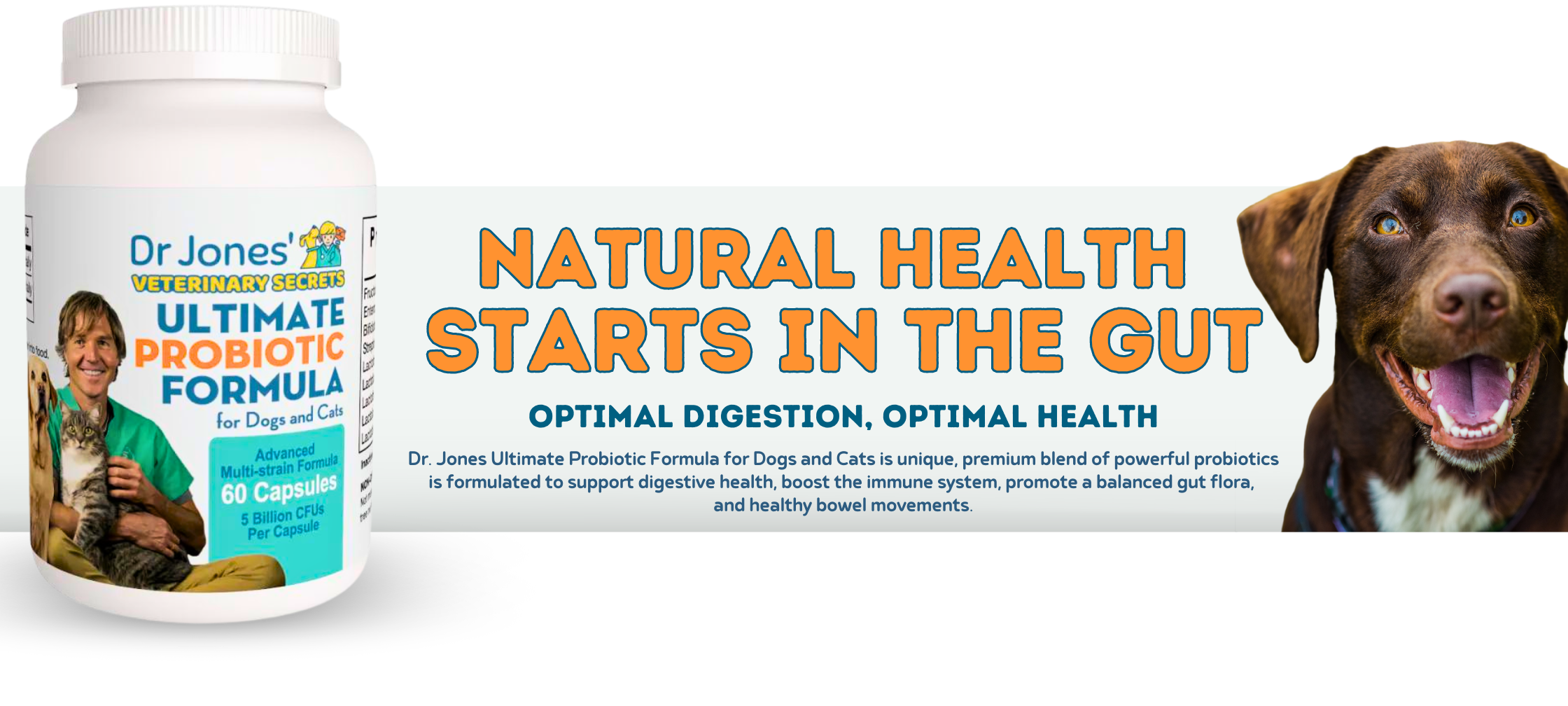
With the right tools and a little effort at home, you can support your pet’s dental health without breaking the bank. Keep an eye on their oral hygiene and consider incorporating probiotics into their routine to make a real difference.

Dr. Jones’ Top Dental Remedies for Dogs and Cats
As a veterinarian, I know how crucial it is to maintain your pet’s oral health. Just like humans, dogs and cats need dental care to prevent gingivitis, plaque, tartar, and other dental diseases. Thankfully, there are many natural and effective remedies you can use at home to help your pet maintain a healthy smile. Here are my top dental remedies for your furry friend.
1. Propolis Spray: A Natural Antibacterial Solution
Propolis is a powerful natural antibacterial and anti-inflammatory herb that is wonderful for dental care. While it’s commonly used by people for sore throats, it’s also highly effective for reducing gingivitis, plaque, and tartar in pets. Multiple studies have confirmed its efficacy.
How to Use:
Spray the propolis once a day for 4 weeks, and you will notice a marked improvement in your pet’s oral health. It’s a safe, effective, and easy-to-use remedy for maintaining healthy gums.
2. Coconut Oil: A Tasty Anti-Bacterial Aid
Coconut oil has been shown in several studies to be an effective antibacterial agent, with some studies specifically focusing on periodontal disease. People who gargle with coconut oil have experienced reduced gum inflammation, less plaque, and less tartar. It’s also a remedy that my own dog, Tula, loves!
How to Use:
Rub coconut oil on your pet’s gumline at least once daily. After 4 weeks, you should assess whether it’s helping improve your pet’s oral health. I’ve seen great results with Tula, and it’s an easy remedy for most pets to tolerate.
3. Coenzyme Q10: Supporting Healthy Gums
Coenzyme Q10 (CoQ10) is essential for generating energy within every cell of the body, especially in the heart and gums. Low levels of CoQ10 have been linked to periodontal disease. In a study, a periodontal specialist discovered that people with gum disease had a significant deficiency of this enzyme. This is particularly applicable to our pets who suffer from recurring gingivitis.
How to Use:
The recommended dose of Coenzyme Q10 is 1mg per pound of your pet’s body weight. Regular supplementation can support healthier gums and overall oral health.
4. Green Tea Rinse: A Simple and Effective Solution
Green tea isn’t just for humans—it’s also a simple and effective natural remedy for reducing plaque, gum inflammation, and bad breath in pets. If your dog or cat swallows some, it’s perfectly safe!
How to Use:
Make a cup of green tea in the morning and use a 20cc syringe to squirt the tea onto the top and bottom of your pet’s gums twice daily. Continue this for 14 days to see if it’s helping, and you can keep using it indefinitely for ongoing maintenance.
5. Proden Dental Care: Seaweed for Better Oral Health
Proden Dental Care is a dental powder containing Ascophyllum nodosum, a type of kelp that helps prevent plaque and tartar buildup. When ingested, it works with your pet’s saliva to stop oral bacteria from forming chains and sticking together.
How to Use:
For pets under 10kg, use 1 scoop per day added to their food. For heavier pets, give 2 scoops per day. Visible improvements typically appear after 4-6 weeks of consistent use. Be cautious—this product should not be used for cats with hyperthyroidism, as it contains iodine which can worsen the condition.
6. Fruits, Vegetables, and Raw Meaty Bones: Nature’s Teeth Cleaners
Fruits and vegetables aren’t just nutritious; they’re also great for your pet’s teeth. Carrots and apples, in particular, are firm, crunchy, and abrasive, which helps break down tartar and plaque.
Raw Meaty Bones:
Giving your dog raw meaty bones twice a week not only satisfies their chewing instincts but also helps keep their teeth clean without the risk of dental fractures. The abrasive action of these bones is perfect for maintaining shiny teeth and healthy gums.
7. Dental Chews: Convenient and Nutritious
Dental chews are widely available, but I’ve found that chews with ground oyster shells provide the best results. They not only help clean teeth but also provide beneficial nutrients like glucosamine and chondroitin. I’ve seen great results with the Plaque Busters Dental Sticks by Crumps, especially with my brother’s dog, Angus.
8. Brushing Your Pet’s Teeth: A Must for Oral Hygiene
Just like humans, dogs and cats need their teeth brushed regularly. You’ll need a toothbrush and pet-friendly toothpaste. Never use human toothpaste as it can be toxic when swallowed. An alternative to commercial pet toothpaste is baking soda.
How to Brush:
When brushing, focus on the gumline, as this is where dental issues like gingivitis are most commonly found.
9. Non-Anesthetic Teeth Cleaning: An Alternative Option
Non-anesthetic teeth cleaning is a technique that some pet owners opt for, especially for pets who cannot be safely anesthetized due to health issues. While I was initially opposed to this, I’ve changed my stance after caring for my own dog with dental issues. Non-anesthetic cleaning can be safe for both young, healthy pets and those with medical concerns.
How to Perform:
Dental hand scalers can be used for non-anesthetic cleaning. I’ve done this with my dog Lewis, cleaning his teeth once a month without anesthesia. For some dogs, this method may be a good option.
10. Home Dental Ultrasonic Scalers: High-Tech at Home
Home dental ultrasonic scalers are an effective way to keep your dog’s teeth clean. These devices use high-frequency vibrations to remove plaque and tartar, helping to maintain fresh breath and healthy gums.
How to Use:
Gently run the scaler along your pet’s teeth, focusing on areas with visible buildup. Regular use of an ultrasonic scaler can help reduce the risk of dental disease and maintain a bright smile.
11. Probiotics for Dental Health
Probiotics can be incredibly helpful in supporting your pet’s dental health. Certain probiotic strains, like Lactobacillus and Bifidobacterium, promote a healthy balance of oral bacteria, reducing harmful bacteria that contribute to plaque, tartar, and gum disease. This can lead to fresher breath and healthier gums.
How to Use:
Adding a high-quality probiotic supplement to your pet’s diet is an easy and effective way to support their dental health. Our Dr. Jones’ Ultimate Probiotic Formula for Dogs and Cats contains high concentrations of these beneficial probiotic strains.

P.S. Some pets, like my dog Tula, are more prone to dental disease. She loves to chew, but dental tartar builds up quickly after a cleaning. On the other hand, my previous dog, Lewis, ate quickly and hardly had any dental problems. By incorporating these remedies, I’ve seen an improvement in my pets’ dental health.
P.P.S. Our new probiotic supplement, Dr. Jones’ Ultimate Probiotic Formula for Dogs and Cats, contains 8 probiotic strains specifically designed for animals—check it out today!

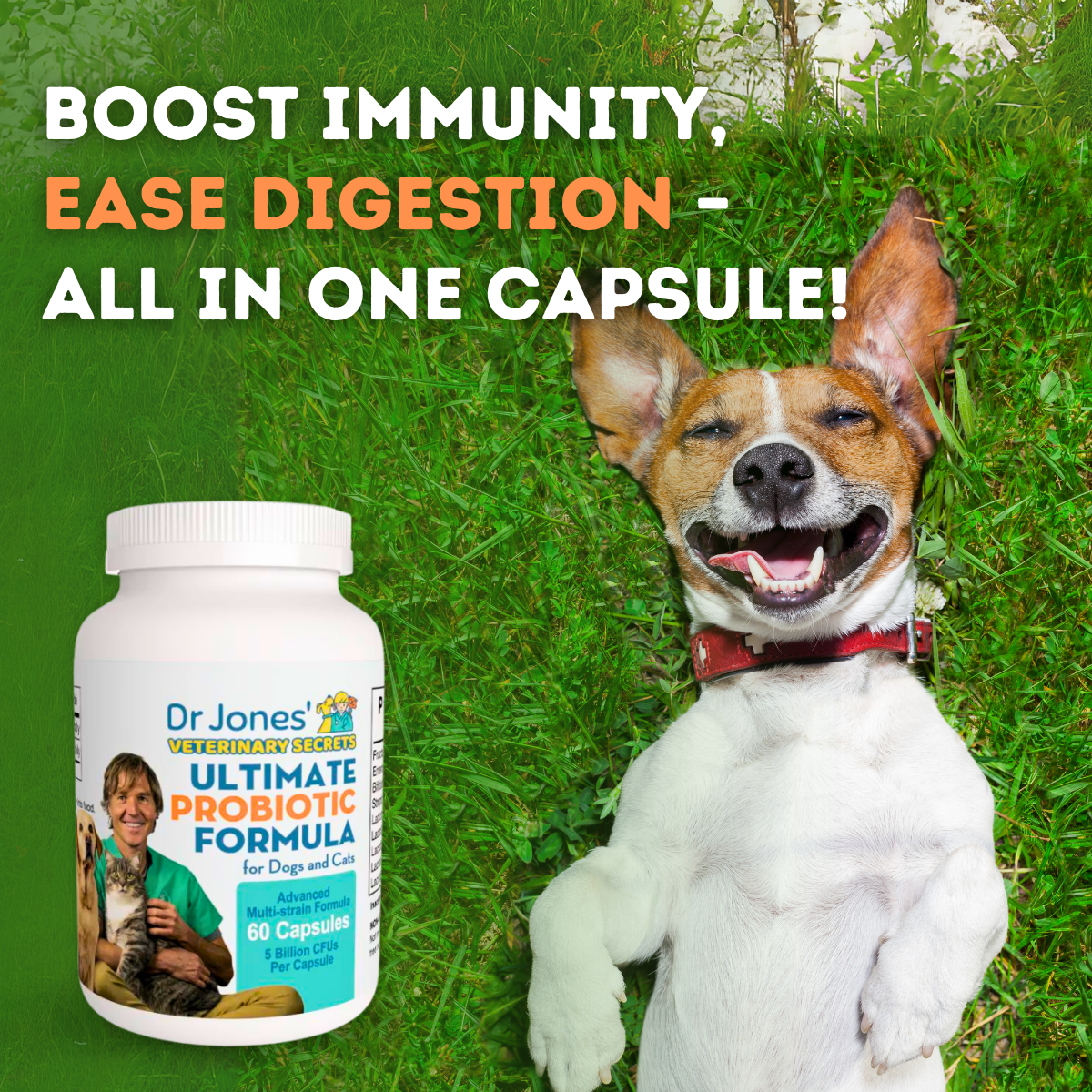
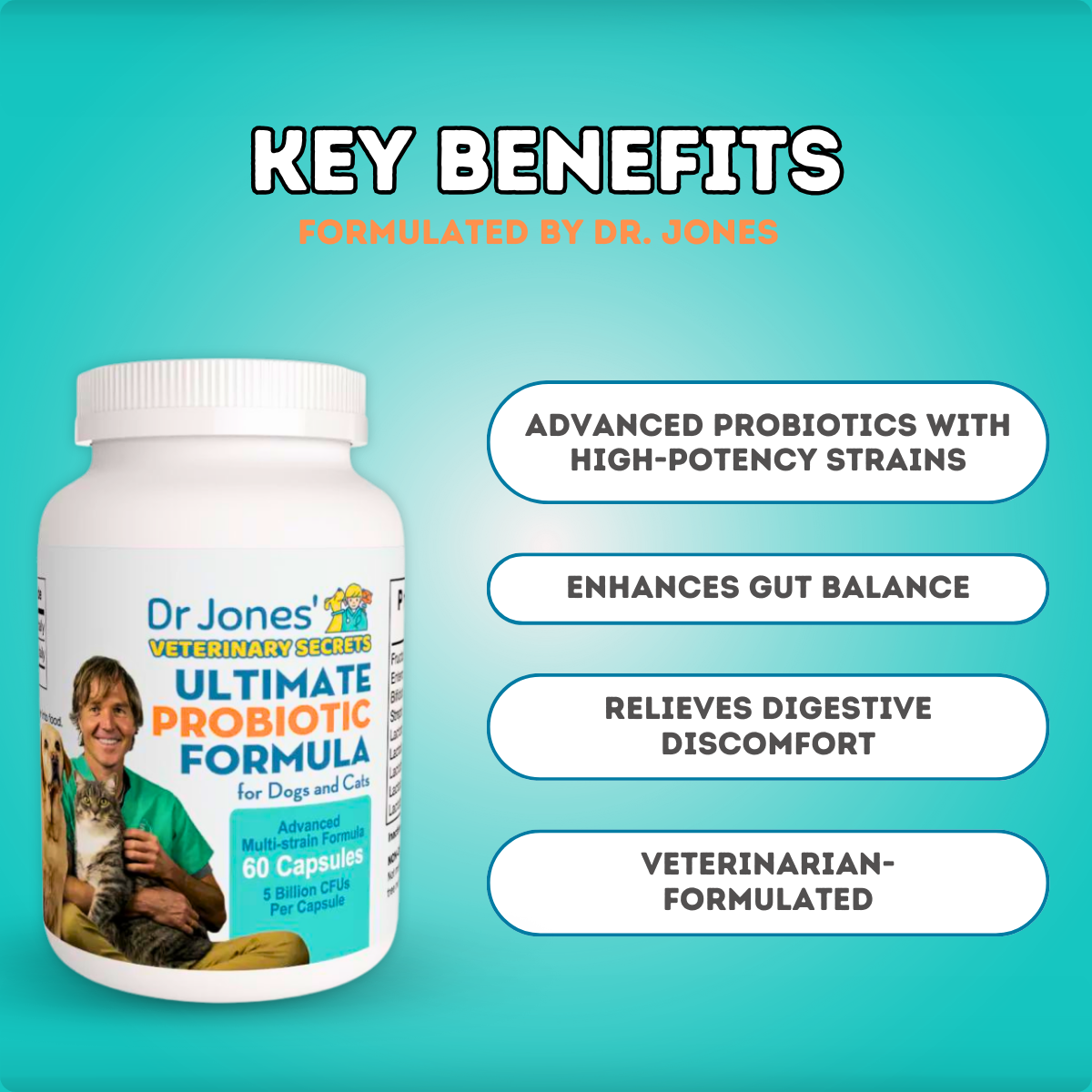
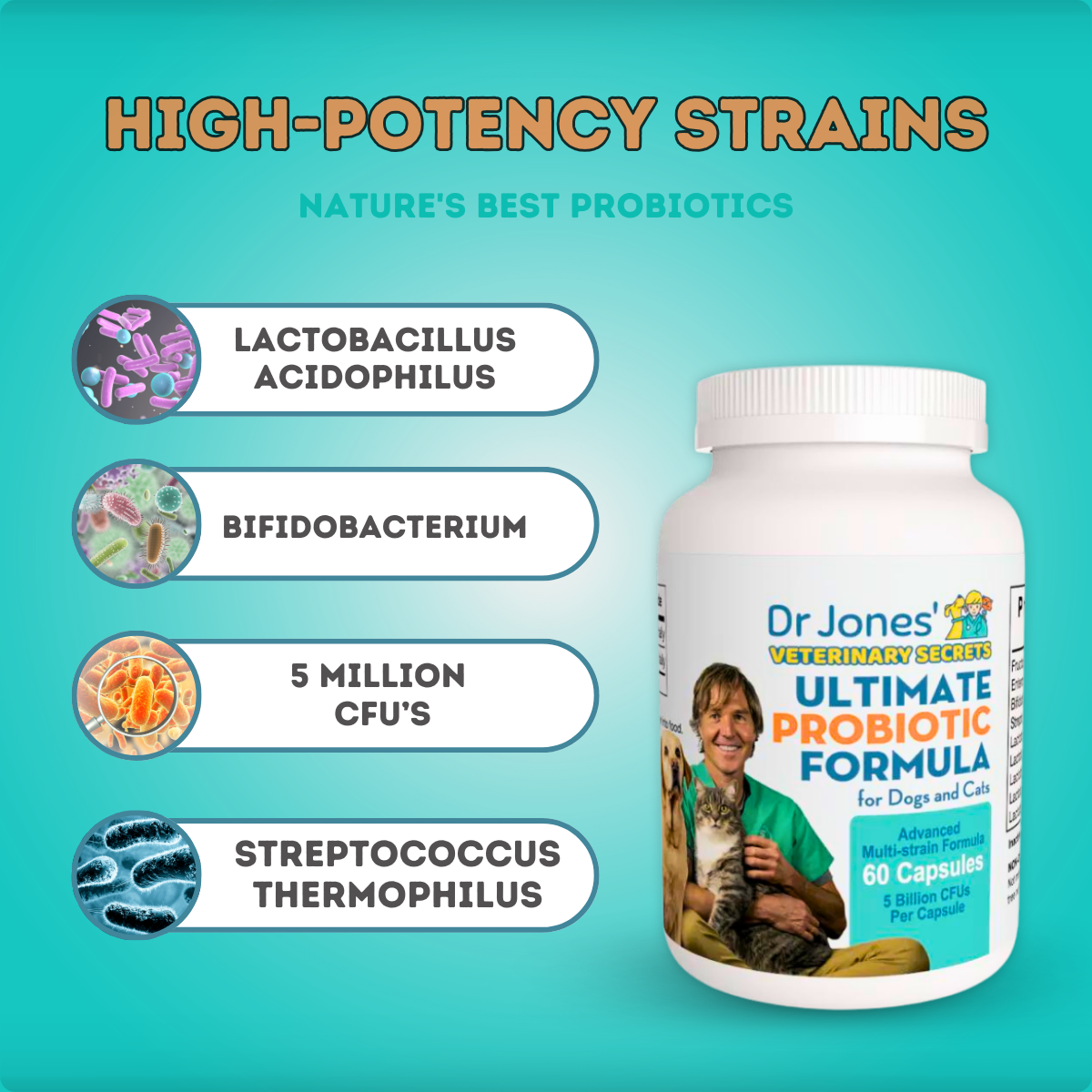
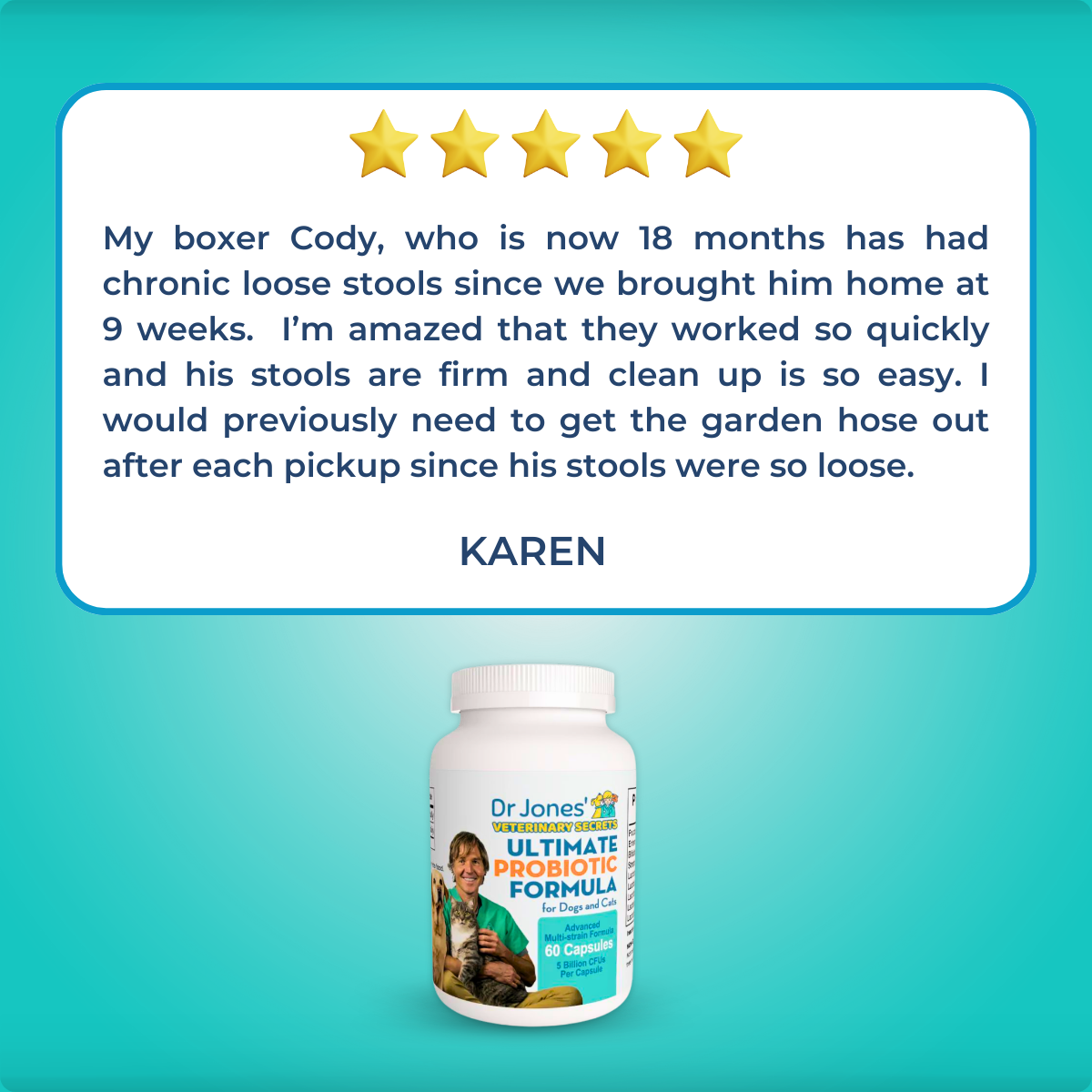
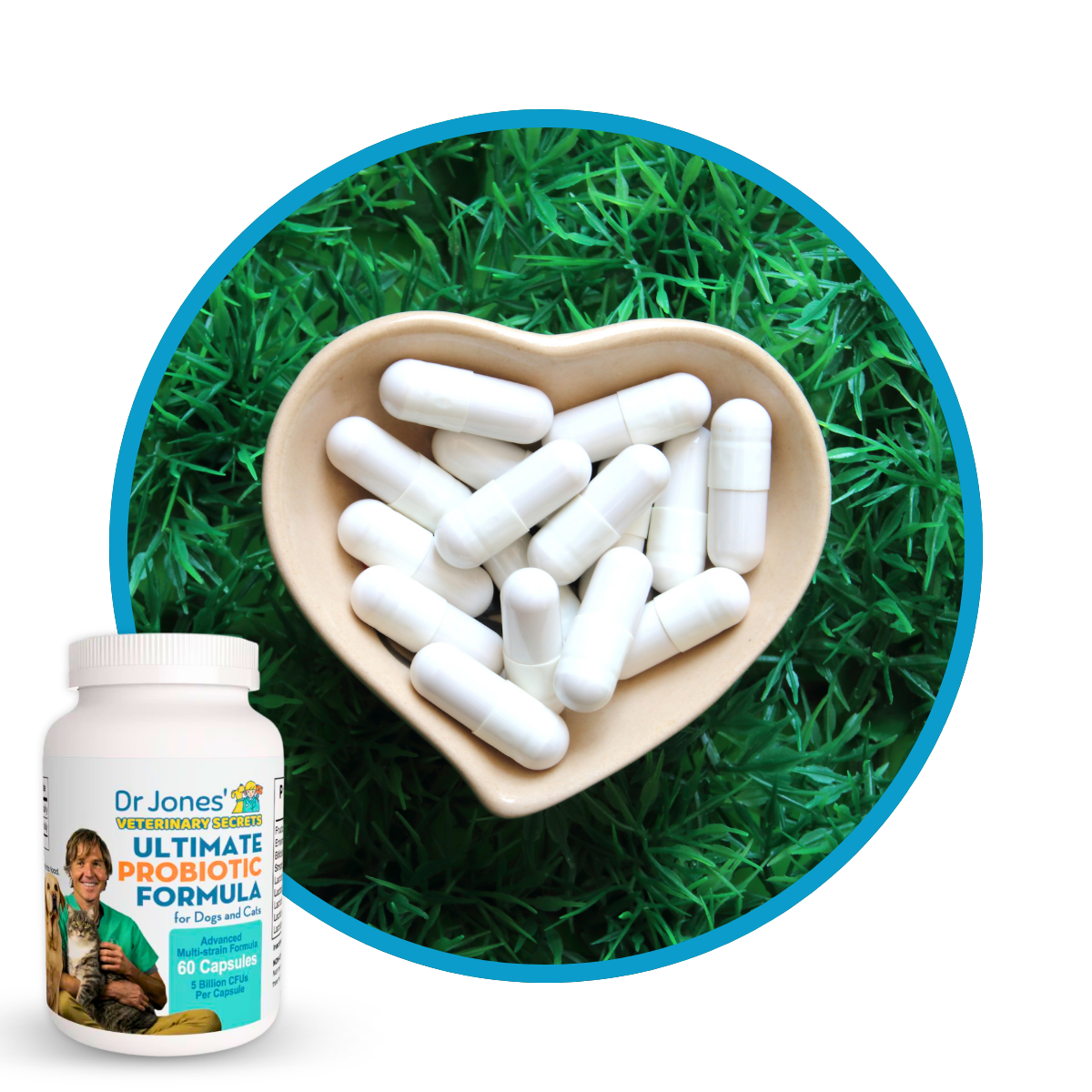
G-morning Dr. Jones…..I recently cued into your web sight once again …..5 years ago I found your site when I was researching for alternative approach to helping my BC Sophie a 37 lbs . Border Collie as she had tore her ACL during an outing playing….I was desperate to help her ….you had given me some good ideas on which way to go with this issue …I did choose to get her medical treatment (TPLO procedure) it was with baited breath I made the choice and luckily I had a bank account for Sophie …expensive yes but it was my for my co-pilot and I could not let her suffer as she was only 8 years old…anyway she made a full recovery and I was elated …I have always been her advocate through all kinds of issues and tried to avoid the modern day Vets for as long as I can remember …Never felt comfortable taking my animal into them unless absolutely necessary …Why, well that’s another story from a previous Collie I had that broke her hawk as a pup and surgery pursued and another large bill…I found a small Veterinarian years later who was attentive on another occasion when I wanted to do a health check on my BC named Narnia…on one occasion he told me to be aware of Vets today as they are milking the pet owners . Wow that’s when I really woke up as was always weary after that until the present day…Recently, well in the last year I wanted to have a wellness Check on my Sophie and went once again to one of the local Vets in town , there are several here on the Island …(they are mostly now all bought up by big corporations). I was not happy on how the Vet for Sophie treated us…rather distant and expensive and always trying to make you feel your not doing the right thing for your Pet and should be coming in more often …Ya sure thing, are you kidding I always felt Milked…$500 here and there…so I would distance myself from them in order to save us both from ruin …but once again I turned to a Clinic for help last year when I noticed my Sophie was licking her back side private parts often , I didn’t notice much more until a time when I noticed she was wet in her backside and there was a wet spot on her bed when she got up…it took all summer plus part of the fall before I realized this is not looking good so I went to a clinic to get a diagnosis …the usual happened , blood test , urin sample and fecal sample…another $500 + and had a phone call from Vet few days later re results over the phone…I was hoping for a in-house discussion face to face but was taken back when that didn’t happen ..So the phone call and the Vet explained over the phone the results , It was overwhelming all at once….when I asked for a copy of the full blood count I was told it would cost me another $20 for costs of printing it out..I complained and said well I would think this would be part of the fee I already paid ie: $540 …it was not …but she said OK , but this is only a One time only for me next time I would have to pay for the paper work…I never went back to that Clinic and decided to check out alternative clinics and found a Family Run Vet..So I booked for Sophie about a week later as I wanted to get another blood work done to compare results..What turned out to be what I thought better attentive care was not what I got, it cost me another $550 dollars and he advised me to go onto Kibbles or canned dog food instead of the homemade meals I was and have been giving Sophie forever (always fresh grass fed food from ethical farmers …that was a shock to me ,,,as how can kibbles and canned dog food be better than homemade consciously made stew or raw food be better…well its not in my mind…this is where I am at with it today as we speak…Sophie urinary incontinence is just that…after I finally understood the Full blood count reference paper and was getting educated on the subject (by the way her blood count showed everything as normal all but one area of concern was a slightly high , BUN 11.8…the concern was possible the start of kidney problem they said ,,,,this test was from the first Blood test I had done, this second blood test was not a full count as I asked for but it for check for signs of hypothyroid condition as her previous first test indicated slightly low T4 level (11.2)…Any way I got out of there somewhat relieved but still a little suffocating from all the overwhelming information to desipher…Over the last Month and half I had contacted a former Lab technician that worked for years with Vetrenarians and now is independently working on her own as a consultant and runs a cat care facility to see what she would advise for Sophies condition…I was advised to change up her diet but still continue the homemade meals or raw but switch around her diet from beef, stew to now lighter meats including chicken , turkey , lamb and organ meats …its only been 6 weeks since the change in diet and Sophie is doing much better and loves her food…she is spirited as much as a 13 year old BC can be hence a little slower than when she was 8 but she still does as a BC does and that is runs like the wind and is eager to prove she still has it in her to explore the grassy fields running playing. The incontinence is not so much a drain on me I’ve learned to deal with it, (washable pee matts, supplements , corn silk husks, and lately Soy Isoflavone , ground flax and pumpkin seeds…I even trying one drop of Ivermectiom per meal…Its been a difficult and time consuming but hopefully I will be able to turn this around even a little but at least I’ m doing what I can and that shows by watching my Sophie , she seems really happy…
What can I give my dog for toothache pain? She has already had a lot of them pulled out as the previous owner did not do anything for her oral hygiene Now I am dealing with her pain and drooling issues. .
Hello Dr Jones,
I first discovered you on YouTube & am so thankful for the content you provide. I have a 10 yr old Norfolk Terrier with stage B2 heart disease with a heart murmur. She’s on pemobendan & enalaprpril. Her teeth & gums are in bad shape & she needs a cleaning. Given she’s a senior dog & has heart disease, my vet did a blood analysis & bile acid test and has approved her to be able to undergo the anesthesia teeth cleaning. It will cost $1100, which is expensive to me. I haven’t scheduled yet. I haven’t noticed her acting as if her teeth hurt her. She eats with no problems & is very peppy & playful for her age. I read all the great advice in this blog post & would like to try some of it. Is it advisable to do some of the things above, like the propolis, coconut oil, & probiotics & avoid the expensive teeth cleaning with the vet? Or is it necessary that I do the teeth cleaning with my vet & use the things mentioned above to maintain afterwards? I look forward to your reply, Thank you Dr. Jones!! 🙂